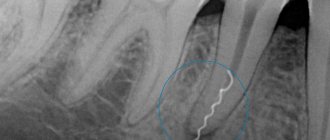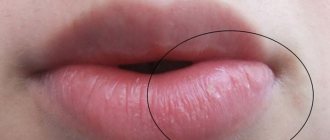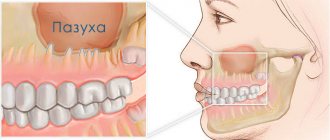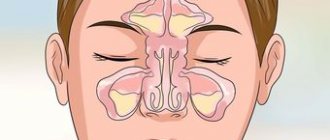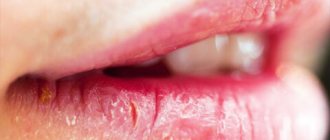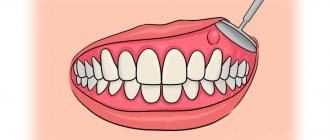Acute sinusitis is an inflammatory process that occurs in the mucous membrane of the nasal appendages (sinuses), so sometimes the diagnosis of sinusitis is also related to inflammation. This disease is characterized by swelling of the cheeks and purulent discharge, accompanied by an unpleasant odor.
In terms of its symptoms at the onset of the disease, the acute form of sinusitis is very similar to a common runny nose, only the treatment of the disease can be more difficult and lengthy. And the condition itself causes enormous discomfort to the patient and interferes with a full life.
Anatomy of the sinuses
There are 4 types of sinuses in the human skull:
- frontal (in the forehead area);
- maxillary, also known as maxillary (in the area of the cheeks under the eyes);
- ethmoid sinuses, or cells of the ethmoid labyrinth (in the area between the nose and eye);
- wedge-shaped (in the very middle of the skull, behind the eyeballs).
The sinuses are peculiar voids that reduce the weight of the skull, participate in the formation and sonority of the voice, in the process of smell, and also serve as shock absorbers for injuries to the facial skeleton.
They also perform a protective function: when foreign particles and bacteria enter the nasal cavity, the nasal mucosa is irritated, sneezing begins, and the particles are evacuated from the body along with mucus. But if the body’s defenses are weakened, bacteria can enter the sinuses from the nasal passages and cause severe inflammation, which is what we observe during the development of acute manifestations of the disease.
Diagnostics
Diagnosis of diseases that are accompanied by swelling of the nasal cavity is carried out by otolaryngologists. The examination program includes a survey, during which the specialist determines the time and circumstances of the appearance of swelling and other symptoms, their relationship with various external and internal factors. The doctor conducts an external examination and prescribes the following diagnostic procedures:
- Rhinoscopy.
Allows you to confirm the presence of inflammation, deformities, tumors, polyps, foreign bodies and traumatic injuries. - Lab tests
. A microbiological examination of nasal discharge is performed to detect bacterial infections, and RIF to detect viral diseases. For tumors, histological or cytological examination is prescribed. - Radiography
. In case of injuries, photographs of the nose are taken, and if sinusitis is suspected, X-rays of the paranasal sinuses are taken.
The listed methods can be supplemented by allergy tests, studying the condition of the pharynx and larynx during pharyngoscopy and laryngoscopy, and other studies.
Rhinoendoscopy
Why do the maxillary sinuses become inflamed more often?
Among inflammations of the paranasal sinuses, acute sinusitis - inflammation of the maxillary sinuses - is most often diagnosed. And there are several reasons for this:
- the maxillary sinuses are the largest in volume;
- The maxillary sinuses are connected to the nasal cavity using anastomoses - small openings covered with mucous membrane (these openings are quite narrow, and even a slight swelling of the mucous membrane with minor inflammation can make it difficult for mucus to come out of them, and the formed and accumulated mucus in the absence of proper outflow becomes a powerful catalyst, if the inflammatory process develops first in neighboring ones.).
Causes of swelling
The maxillary (or maxillary) sinuses are located under the eyes in the thickness of the upper jaw[1]. The entrance to the sinuses is located on the lateral walls of the nasal cavity. The mucous membrane covers the paranasal sinus from the inside. It is necessary for a complete outflow mechanism. The production of mucus in all paranasal sinuses is considered normal. It is necessary to absorb pathogens or solid foreign particles and further remove them from the nasal cavity.
The mucosa consists of multirow epithelium with mobile cilia[2]. They constantly drain fluid from the sinuses. The hole for this is located in the upper part of the sinuses. The process is practically impossible if the mucus secretion mechanism is disrupted. Also, the anastomosis (opening) itself, connecting the sinus with the nasal cavity, has its own mucous membrane. If it swells, then this hole becomes narrow, and the outflow of mucus through it occurs with great difficulty.
If a person is completely healthy, then all of the listed mechanisms work very harmoniously. In this case, sinusitis simply cannot develop. But if an inflammatory process occurs in the nasal mucosa, then not only it swells, but also the mucous membrane of the adjacent anastomosis and maxillary sinus. As the mucous membrane swells, the gap between the sinus and nasal cavity gradually closes.
When the mucous membrane swells greatly and the anastomosis narrows, the maxillary sinus becomes completely cut off from the nasal cavity[3]. Under such conditions, pathological changes occur in it: hypoxia sets in, pressure increases, and the active production of mucus continues, which has nowhere to go due to impaired outflow, so it stagnates in the sinuses. Over time, a strong inflammatory process develops, and the contents of the sinuses become purulent.
Types of acute sinusitis
There are catarrhal and purulent forms of sinusitis.
Make an appointment right now!
Call us by phone or use the feedback form
Sign up
The name “catarrhal” comes from the medical term “catarrh,” meaning “to flow, drain.” That is, with this form of sinusitis, inflammation of the mucous membrane and its swelling develop quite quickly. Initially, the changes affect only the mucous membrane. Inflammation during sinusitis of this form is accompanied by severe swelling of the mucous membrane - it noticeably increases in size and, as a result, a little later transparent mucus forms. Only thanks to timely treatment, it is possible to prevent the transition of catarrhal forms into purulent sinusitis, which with a high degree of probability can become chronic.
With purulent sinusitis, direct contact of pus with the mucous membrane degenerates it, quite quickly and, what is most dangerous, irrevocably. Thus, with improper treatment or no treatment at all, you can very easily and simply join the army of people suffering from a chronic form of sinusitis.
The cause of the purulent form of sinusitis (acute sinusitis) is bacteria. The secreted mucus contains streptococci, staphylococci, and less commonly pneumococci and fungi, which leads to the appearance of purulent contents in the sinus itself.
How to relieve swelling from sinusitis: safe ways
Many people are very afraid of punctures and are interested in how to relieve swelling of the maxillary sinuses in more gentle ways. A good alternative to puncture is the YAMIK sinus catheter [8]. This device was developed by Yaroslavl specialists - G.I. Markov. and Kozlov V.S. During therapeutic manipulation, the mucous membranes are not injured and the bone structures of the nasal cavity are not damaged.
With this procedure, it is possible to restore normal communication between the sinus and nasopharynx, as well as locally administer antibiotics or antiseptics. The principle of operation of such a catheter is to seal the nasal cavity and create negative pressure in it.
After inserting a thin catheter into the nasal cavity, the patient's pressure changes, which eliminates swelling and improves local blood circulation. As a result, the functionality of the ciliated epithelium is restored, and the pathological contents from the sinuses are easily removed[9]
Reasons for the development of sinusitis
Acute sinusitis can be caused by the following factors:
- colds;
- viral infections: ARVI, measles, influenza, etc.;
- allergic reactions;
- damage and injury to the nose;
- untreated teeth, tooth roots entering the cavity of the maxillary sinus, inflammation of the gums.
In medicine, it is customary to distinguish two ways of infection entering the maxillary sinuses: when the infection penetrates from the nasal mucosa into the maxillary sinus or when the infection develops directly in the maxillary sinus through blood flow and general inflammation.
Sinusitis (in addition to bacteria) can be provoked by factors that interfere with normal air circulation and the release of mucous masses from the sinuses. These include:
- deviated nasal septum;
- adenoids;
- cyst;
- polypous formations;
- and etc.
Unfavorable environmental conditions - dust, gas pollution, work in hazardous industries - can also disrupt the process of the release of mucous masses from the sinuses and further treatment.
What is sinusitis?
Sinusitis refers to inflammatory diseases of the paranasal sinuses (sinusitis).
Attention! In this case, the sinuses, located on both sides of the nose in the bones of the upper jaw, become inflamed. These maxillary sinuses become inflamed equally often in children and adults.
The main purpose of such cavities is to equalize pressure in the external environment and intracranial bones. Such processes occur due to communication between the cavities and the nose through narrow openings.
If inflammatory processes develop, these sinuses become blocked and phlegm and mucus begin to accumulate in them .
In it, when the disease is of infectious origin, pathogenic microflora develops, which aggravates the symptoms.
Swelling of the face in the eye area in this case is due to the fact that the inflamed sinuses are located close to such areas, and with an increase in the size of the inflamed tissues, this manifests itself visually.
In this case, sinusitis can be one-sided or affect both sinuses, and in the first case, swelling of the eye and face occurs only on the side of the inflamed eye.
Symptoms
Symptoms of acute sinusitis include:
- pain in the cheek area under the eyes;
- pain in the orbital region;
- pressure on teeth and toothache;
- headache;
- pain when tilting the head forward (the pain “radiates” to the back of the head and forehead; the nature of the sensation resembles the pain of a migraine; as a rule, the pain intensifies in the evening);
- difficulty breathing through the nose;
- a feeling of continuous nasal congestion (it may be accompanied by itching, sneezing, dryness);
- the nature of the mucous discharge helps determine the severity of the disease (transparent discharge in a mild form of the disease and thick green discharge in a purulent form);
- bad odor from the nose and mouth (the nose and pharynx are connected to each other; with sinusitis, pus accumulates in the sinuses and causes bad breath; it is difficult to get rid of it, even after brushing your teeth);
- eyes become watery;
- nasality appears in the voice;
- impaired sense of smell;
- high body temperature from 37.5 to 39°C - the body’s response to the presence of infection;
- increased fatigue, decreased appetite, sleep problems;
- swelling of the eyelids, cheekbones, and areas near the nose;
- pain when pressing on the area where the sinuses are located.
Are complications possible with acute sinusitis?
With delayed treatment or lack of properly selected treatment, acute sinusitis can become chronic and lead to the development of a number of other serious complications.
Friends! Timely and correct treatment will ensure you a speedy recovery!
Chronic inflammation in the sinuses is the most common complication of acute sinusitis. The chronic form requires long-term competent treatment.
An infection from the maxillary sinuses can enter the middle part of the ear and provoke a severe inflammatory process there (otitis media). Otitis is accompanied by sharp pain in the ear, hearing loss occurs, and body temperature may rise.
Diseases of the ternary nerve are associated with sinusitis, since it is located close to the source of inflammation. This condition is characterized by shooting pains in the face. Patients describe the sensations as electric shocks. Such neuritis is extremely difficult to treat.
Complications of sinusitis associated with the eyes are possible. With inflammation, we observe swelling of the eyelids, pain when pressing on the eye socket, and vision may begin to “deteriorate.” Pus entering the eye socket and vein thrombosis can lead to loss of vision and even loss of the eye itself (panophthalmitis).
The worst consequence of sinusitis is inflammation of the lining of the brain (meningitis). A similar complication develops with prolonged and incorrect attempts to independently cure sinus inflammation.
Other common complications of sinusitis in adults: periostitis of the jaw, meningoencephalitis, sinus thrombosis, up to generalized blood poisoning (sepsis).
Remember, sinusitis with complications is much more difficult to treat, so it is very important to promptly seek qualified help from an ENT specialist.
How is diagnosis carried out?
Treatment of acute sinusitis in adults and children must be carried out under the supervision of an experienced otolaryngologist.
At the appointment, the ENT doctor will collect anamnesis and conduct an examination of the nasal cavity. Painful sensations when palpating the area under the eyes at the level of the cheeks will indicate the presence of an inflammatory process in the sinuses.
A reliable diagnostic method is x-ray examination. But young children and pregnant women are not prescribed x-rays. They are shown CT and ultrasound examination of the sinuses - sinus scanning.
To obtain complete information about the disease, rhinoscopy and endoscopy of the nasal cavity and nasopharynx are performed.
Anti-inflammatory drugs
Glucocorticosteroids are popular among otolaryngologists. They have the following effect[11]:
- suppress the development of mucosal edema;
- restore the functional ability of the openings connecting the nasal cavity and sinuses;
- prevent the development of blood eosinophilia;
- reduce inflammation caused by the interaction between cells of the nervous and immune systems.
Also, in order to eliminate the inflammatory process in case of sinusitis, complex preparations based on medicinal plants can be prescribed.
Treatment methods for acute sinusitis
The mildest disease does not require the use of any special measures or antibacterial agents for treatment. It is enough to take anti-inflammatory drugs to relieve general symptoms and use vasoconstrictor drops to relieve swelling and facilitate the release of mucus.
Sinusitis with a purulent form is treated with the help of antibiotics (for example, Amoxiclav).
Therapy for the acute form of the disease is best supplemented by rinsing the nasal cavity and paranasal sinuses. The most effective method of treating sinusitis is Proetz lavage, better known as the “cuckoo” method.
Physiotherapeutic procedures and irrigation of the nasal cavity with antiseptic agents will help to consolidate the effect of treating sinusitis.
Washing “cuckoo”: description of the method of treating sinusitis
The “cuckoo” method is a painless and, most importantly, effective procedure. Thanks to conservative treatment, purulent masses, mucous secretions along with pathogenic microorganisms are effectively washed out of the sinuses, the mucous membrane improves its function, nasal congestion decreases, and inflammation subsides. In some cases, thanks to Proetz lavage, puncture can be avoided. How is this procedure carried out?
The patient is positioned comfortably, lying on the couch, face up. The ENT doctor carefully pours an antiseptic into one nostril (Chlorhexidine, Furacilin, Miramistin, etc.). And at the same time, with the help of a special metal olive connected by a medical suction device, it sucks out this rinsing solution, but from the other nostril. The manipulation is repeated three times on each side, using a sterile plastic syringe with a volume of twenty ml. The entire procedure lasts about five minutes.
Puncture for sinusitis
If all conservative methods of treating sinusitis do not help, the ENT doctor will suggest a puncture of the maxillary sinus. This measure is necessary because pus accumulated in the sinus, as we already know, can lead to serious consequences, including inflammation of the brain.
During the procedure, the otolaryngologist releases the purulent contents of the sinuses and injects medication into the sinus. There is no need to be afraid of a puncture - before the procedure, anesthesia is performed: the ENT doctor inserts a cotton swab soaked in a lidocaine solution into the nasal passage of the patient sitting in a chair. It is completely safe and does not require patient preparation.
As soon as the anesthesia takes effect, the otolaryngologist, using a Kulikovsky needle, carefully inserts it into the sinus through the nasal cavity. Using a syringe, the purulent contents are sucked out. As soon as the purulent masses are completely removed, rinsing is carried out. The sinus should continue to be rinsed for several days after the procedure.
Why does swelling of the eyes and face develop with sinusitis?
Initially, swelling with sinusitis occurs in the sinuses.
At the same time, experts argue that this is not only a consequence of the development of inflammation, but also an additional protection of the body from pathogenic microorganisms entering the body through the nose (swelling narrows the maxillary sinuses and acts as an additional barrier).
Know! It is useless to eliminate the swelling itself during sinusitis, and if the root causes of the pathology are not identified in time and treatment is not started, the inflammatory processes continue to spread and spread to the face in the eye area.
The reason for the development of such swelling may be :
"ENT clinic of Doctor Zaitsev"
Our clinic specializes in the treatment of ear, nose and throat diseases. The most modern equipment, our own techniques and experienced specialists are the three components that will allow you to treat acute sinusitis quickly, safely and effectively. Regular clients of our clinic notice that our prices remain at the 2013 level!
When the first signs of sinusitis appear, please do not delay visiting a doctor. Call and make an appointment - we are always ready to help you!
